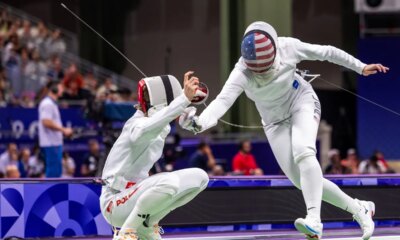Culture
When athletes win Olympic gold medals in Paris, they'll get a piece of the Eiffel Tower

Winning an Olympic gold medal is considered a crowning achievement for an athlete, so it’s only fitting that the physical medal represents the significance.
What’s on each gold medal is special for every Olympic Games, but Paris 2024 is particularly notable because, when athletes win gold, they will take home a piece of the Eiffel Tower, an iconic landmark of the host city.
The Eiffel Tower played a major role in the Paris 2024 opening ceremony. From beaming lights and the Olympic rings to the comeback performance of Celine Dion, “La Tour Eiffel” showcased its grandeur to the world. And now, it will be part of the athletes’ medal collections.
What else is unique about these gold medals and how are they connected to the Eiffel Tower? Here’s what to know.
How many Olympic medals are created?
Around 5,084 medals were developed for Paris 2024, per multiple reports, which note that approximately 2,600 medals have been created for the Olympics and 2,400 for the Paralympics.
How much do the Olympic gold medals weigh?
The gold medal weighs 1.17 pounds. The silver medal, by comparison, weighs 1.16 pounds while the bronze is one pound.
Who designed the Olympic gold medals?
Chaumet, the French luxury jewelry and watch brand, designed the Olympic medals. Founded in 1780, Chaumet is owned by LVMH (Moët Hennessey Louis Vuitton).
What features are on the Olympic gold medals?
The Olympic gold medal consists of three features: the hexagon, radiance and setting.
In the middle of the medal is a hexagon. It pays homage to France’s nickname “L’hexagone” given the country’s roughly six-sided shape.
The hexagon is surrounded by several strand-like shapes. This symbolizes the radiant light, as Paris is often referred to as the “city of light.”
On the six edges of the hexagon are claw settings. The shape is similar to those found in the rivets on the Eiffel Tower.
Olympic rings were illuminated on the Eiffel Tower during the opening ceremony of 2024 Games in Paris. (Photo: Ludovic Marin – Pool / Getty)
What is the Eiffel Tower connection?
The Eiffel Tower was the defining fixture of the 1889 World Fair. The original tower was made with wrought iron.
When the Eiffel Tower underwent renovations in the 20th century, they preserved pieces of the original iron and kept them in storage. Those chunks make up the hexagon figure in the middle of the Olympic gold medal.
According to multiple reports, 0.04 pounds of iron renovation pieces from the Eiffel Tower are included in each medal.
Gold, silver and bronze medals began at the 1904 St. Louis Olympic Games. It’s estimated that 1,011 medals — in terms of the Games’ medal count — will be handed out at Paris 2024 (more medals were developed to account for team events). This is the first time a piece of a city’s historic landmark is included in an Olympic medal.
How much is an Olympic gold medal worth?
According to Forbes, a Paris 2024 Olympic gold medal is worth approximately $950.
What happens at the medal ceremony?
The gold medal is placed around the winning athlete’s neck atop the podium. The athlete also receives a stuffed souvenir of the Paris 2024 mascot. Then, the national anthem of the winning athlete’s country plays — a tradition that began for gold medalists at medal ceremonies in 1932.
Required reading
More on the 2024 Paris Olympics from The Athletic…
(Photo: Thomas Samson / AFP via Getty Images)

Culture
Do You Know the Notable Buildings Mentioned in These Books?

A strong sense of place can deeply influence a story, and in some cases, the setting can even feel like a character itself. This week’s literary geography quiz highlights buildings that inspired authors, often to the point of including the structures in their novels. (Many of the buildings are still open to visitors.) To play, just make your selection in the multiple-choice list and the correct answer will be revealed. At the end of the quiz, you’ll find links to the books if you’d like to do further reading.
Culture
Video: 250 Years of Jane Austen, in Objects

new video loaded: 250 Years of Jane Austen, in Objects
By Jennifer Harlan, Sadie Stein, Claire Hogan, Laura Salaberry and Edward Vega
December 18, 2025
Culture
Try This Quiz and See How Much You Know About Jane Austen

“Window seat with garden view / A perfect nook to read a book / I’m lost in my Jane Austen…” sings Kristin Chenoweth in “The Girl in 14G” — what could be more ideal? Well, perhaps showing off your literary knowledge and getting a perfect score on this week’s super-size Book Review Quiz Bowl honoring the life, work and global influence of Jane Austen, who turns 250 today. In the 12 questions below, tap or click your answers to the questions. And no matter how you do, scroll on to the end, where you’ll find links to free e-book versions of her novels — and more.
-

 Detroit, MI6 days ago
Detroit, MI6 days ago2 hospitalized after shooting on Lodge Freeway in Detroit
-

 Technology3 days ago
Technology3 days agoPower bank feature creep is out of control
-

 Dallas, TX4 days ago
Dallas, TX4 days agoDefensive coordinator candidates who could improve Cowboys’ brutal secondary in 2026
-

 Health5 days ago
Health5 days agoViral New Year reset routine is helping people adopt healthier habits
-

 Nebraska2 days ago
Nebraska2 days agoOregon State LB transfer Dexter Foster commits to Nebraska
-

 Iowa3 days ago
Iowa3 days agoPat McAfee praises Audi Crooks, plays hype song for Iowa State star
-

 Nebraska3 days ago
Nebraska3 days agoNebraska-based pizza chain Godfather’s Pizza is set to open a new location in Queen Creek
-

 Entertainment2 days ago
Entertainment2 days agoSpotify digs in on podcasts with new Hollywood studios

























